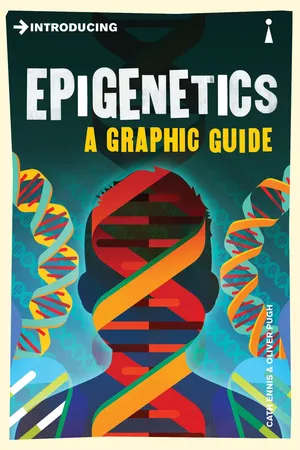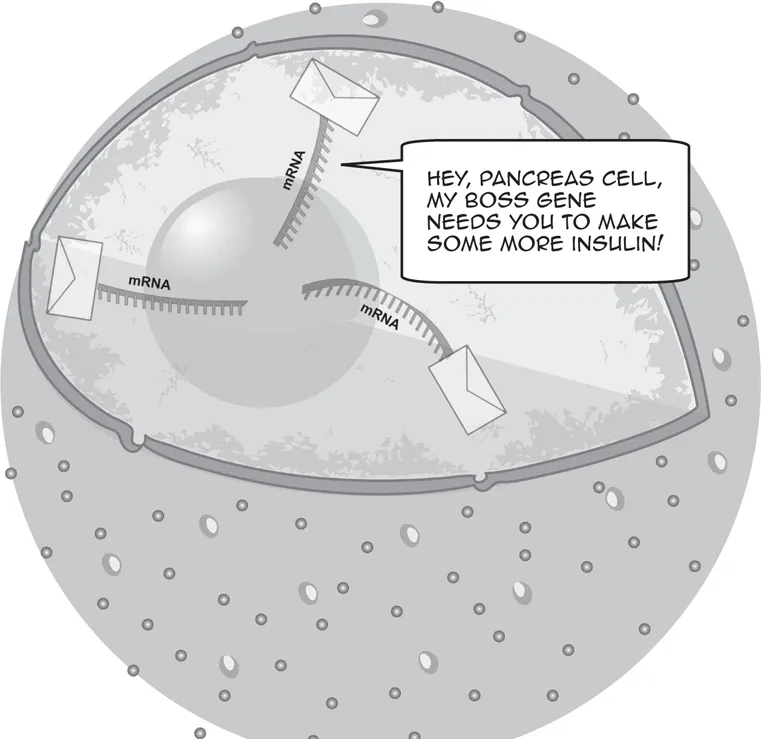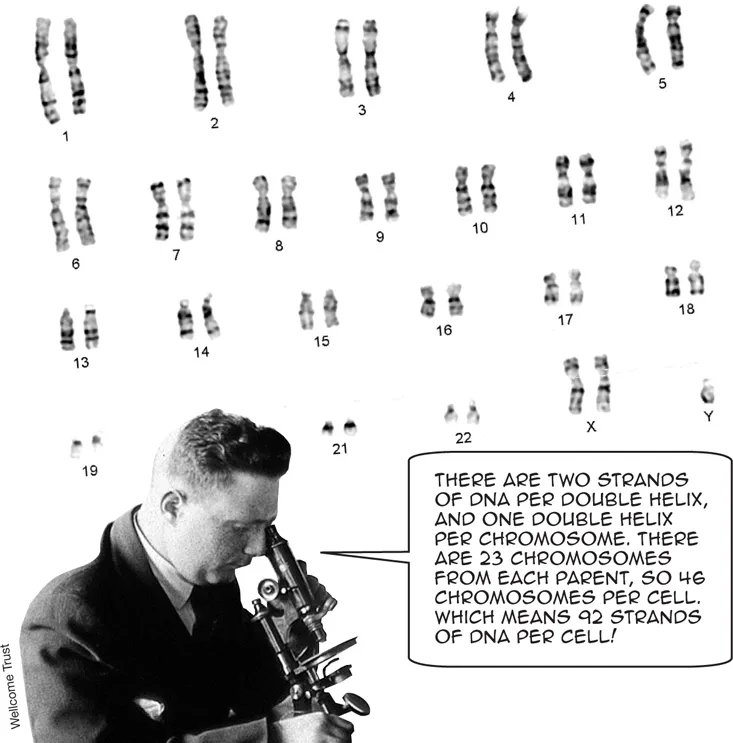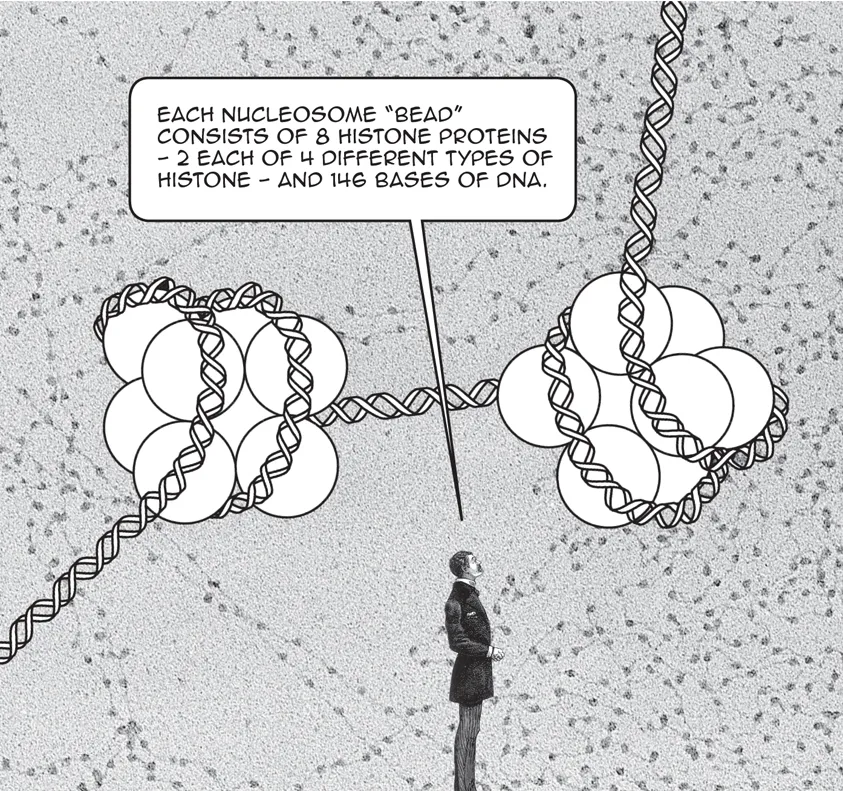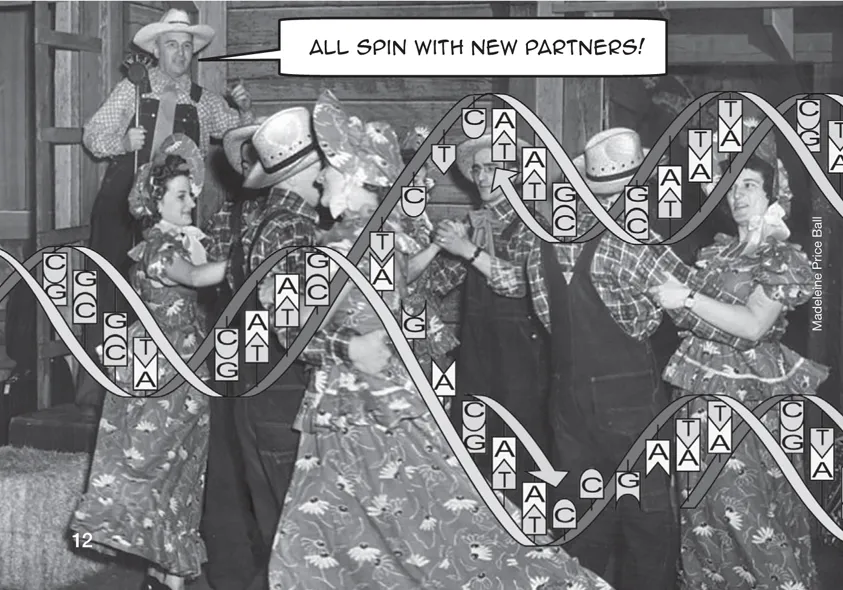![]()
Genes, RNA and Proteins
Epigenetics is about how the genes* we inherit from our parents are controlled, and how they interact with our environment: how our genes make us, well, us.
“Epi-” means upon, or in addition; epigenetics is the study of how additional factors interact with genes to direct the processes that make our cells* and bodies work.
Scientists have known about some of these factors for decades, but have only quite recently begun putting everything together to start explaining some of the gaps in our knowledge of genetics. From how embryos develop to how species evolve, from basic laboratory research to drug development – epigenetics is becoming a hot topic of conversation!
* Words marked with an asterisk are defined in the glossary.
To understand epigenetics, we first need to know some basic genetics.
Genes are made of deoxyribonucleic acid (DNA)*. DNA consists of long strings of four component molecules*, called bases*: A, C, G and T. The order, or sequence, of these bases along the string serves as our genetic code.
Two long strings of DNA coil around each other to form the famous double helix structure. The bases on one strand form connections with the bases on the other strand; these connected pairs are the “rungs” in the twisted ladder-like structure of the helix. A always connects to T, and C always connects to G.
The first step in translating the DNA’s coded instructions is called transcription*. Part of the helix opens up, and the bases on one strand connect to new matching (“complementary”) base molecules. The new bases link together into a strand of ribonucleic acid (RNA)*. RNA is similar to DNA, but its short, single strands are less stable and more mobile than the DNA’s long double helix.
Some types of RNA can squeeze out through tiny holes in the membrane that surrounds the cell nucleus*. DNA is too big to get through, so these RNA molecules act as coded messages from the genes to the rest of the cell.
Some of the RNAs that leave the nucleus are called messenger RNAs (mRNAs)*. mRNAs are copies of those sections of the DNA that code for large molecules called proteins*.
Proteins are extremely important. There are thousands of different types, each with a specific function. Many proteins help to control the chemical reactions that keep our cells alive and healthy. For example, proteins are needed to open up the DNA double helix and to join individual bases together into RNA strands during transcription. Other proteins are involved in digesting food, fighting infections, carrying oxygen around the body, and thousands of other diverse functions.
The process of converting mRNA sequences into proteins is called translation*.
Each three-base unit – called a “codon”* – of mRNA connects to a transfer RNA (tRNA)* strand that has three complementary bases at one end. The other end is attached to a molecule called an amino acid*. There are different types of amino acid, and each type can only attach to tRNAs that match specific codons.
Just as bases are the building blocks of DNA and RNA, amino acids are the building blocks of proteins. As tRNAs connect to their matching codons along an mRNA strand, their amino acids join up in the same order.
The sequence of amino acids in each protein is specified by the sequence of codons in the corresponding mRNA, which in turn matches the sequence of bases in the DNA. The very specific relationship between a given mRNA codon and its matching tRNA molecule, which is only ever attached to a single type of amino acid, is essential to the conversion of the DNA’s code into proteins.
The sequence of amino acids in a protein determines its function. As we saw before, protein functions are essential for life. This is why DNA is so important – it contains all the instructions needed to make our cells and bodies work.
Chromosomes, Nucleosomes and Chromatin
Our complete DNA sequence is called our genome*. All humans have extremely similar genomes, although we each have a slightly different version of the sequence. Almost every cell in your body contains its own copy of your unique version of the human genome.
The human genome is divided into 23 sections called chromosomes*. Chromosomes come in pairs: we each inherit one chromosome of each pair from our mother, and the other from our father. The longest human chromosome contains about 2,600 protein-coding genes; the smallest, just 140. Genes are separated by stretches of non-protein-coding DNA.
There are about 21,000 protein-coding genes in the human genome, which contains 3 billion individual bases (A, C, G and T). Laid out end-to-end, the DNA contained in a single cell would be about 1.8 metres (five feet) long. The DNA has to be twisted, folded and compacted to fit into a tiny cell nucleus.
The double helix first wraps around a cluster of eight small proteins called histones*, which bind very tightly to DNA. Each individual unit of eight histone proteins plus DNA is called a nucleosome*. The nucleosomes that assemble along a stretch of DNA look like beads on a string.
Four types of histone protein make up the nucleosome beads. A fifth type of histone protein attaches to the linker DNA between nucleosomes, and also to the histones inside each adjacent nucleosome. These connections compact the “beads on a string” into a thicker strand. Additional proteins, called scaffolds, bind to this strand and loop, fold and bend it into even denser structures.
The combination of DNA, histones and scaffold proteins, plus other proteins and RNAs that bind to the overall structure, is called chromatin*.
The density of the chromatin varies along the length of each chromosome. You can actually see this variation in photographs of dyed cells – chromosomes are stripy, with the darker bands corresponding to regions of denser chromatin.
DNA Replication and Mitosis
New cells are constantly being created in our bodies, via a process called cell division*.
Before a cell can divide in two, it has to make a second copy of its genome. This DNA replication process happens in a similar way to RNA transcription. The double helix opens up, breaking the connections between the two strands. The bases on each strand reconnect to complementary new partners, which link together into new strands of DNA.
The result at the end of the process is two double helices, each comprising one old strand of DNA from the original cell, and one newly formed strand.
Most cell divisions are of the type called mitosis*, a process that creates two new cells which each have the same number of chromosomes as the original cell.
The chromosomes enter mitosis all jumbled up together like a bowl of spaghetti. As mitosis begins, they separate, condense and form pairs with their newly replicated copies. Fibres then extend out from opposite ends of the cell. Each...
